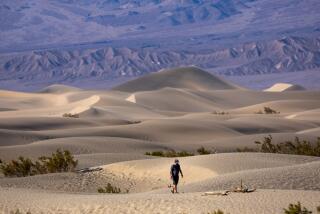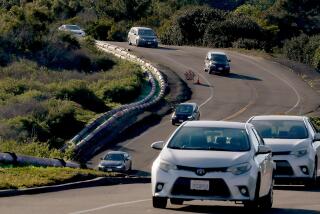Chewing on dirt
In a valley south of Ensenada, thousands of race fans wake at scraggly campsites to the sight of rising dust and feel of trembling earth. It’s the all-day plane crash, as one racing legend has dubbed it — an off-road armada of 300 bikes, buggies, quads and trucks roaring this way.
The first motorcyclist flashes past in an explosion of dirt. A chase helicopter swoops overhead. The hordes spring from their campfires toward the action. Despite speeds of up to 100 miles per hour, bystanders jam the roadside, leaving bikers and drivers millimeters for error.
“Have you ever been startled or scared, really scared?” asks Dave Ashley, a truck racer who’s been competing here since the ‘80s. “Imagine that happening for a full four, five hours . You get this incredible adrenaline pump, and it just lasts the whole time.”
And it’s not only drivers who feel the buzz. A thrill-seeking teenager dashes out of the crowd and across the course like a bull-dodger at Pamplona, winning an ovation. Then a civilian cycle takes the dare, lurching across the track. Then a car.This is no traffic cop’s nightmare; it all materialized last June, at the running of the 2004 Tecate Score Baja 500. There will be more of the same Thursday, when another 280 kidney-thumping devotees line up for the Baja 1,000, a.k.a. the Tecate Score Baja 1000, a.k.a. the Baja Mil, a.k.a. the granddaddy of desert racing.
For 37 years, these races have endured despite deaths and injuries, despite prize money that’s pocket change next to NASCAR’s winnings, and despite perpetually dodgy local politics.
Along the way, the races have grown into a sort of a brand name for manly challenge. Steve McQueen, George Plimpton, James Garner, Ted Nugent — all have skidded here. It was Parnelli Jones, Baja repeater and Indianapolis champion, who called the Baja Mil “a 24-hour plane crash.”
But as Baja’s population grows and environmentalist sensibilities edge south across the border, the future of these races looks about as clear as the dust-choked route.
“These races have little to no environmental oversight, and the maximum speeds they encourage result in maximum damage to the landscape and wildlife just so gringo motorheads can rip it up,” says Daniel Patterson, a biologist at the Tucson-based Center for Biological Diversity.
“The environmental matter is becoming very, very touchy,” acknowledges Oscar Ramos, the Tijuana attorney who serves as race promoter Sal Fish’s right-hand man in Mexico. “They want to put tougher conditions on us.”
Still, the roster of starters for this year’s Baja 500 was the longest in 15 years. And within its first hour, the race had slipped into the usual chaos.
At mile 50, 28-year-old Ricardo Flores of Tijuana and a dozen buddies pulled their truck up to a creek and built a little dam. They are among perhaps 100,000 spectators out today, and their dam has converted a little trickle into a 3-foot-deep water hazard.
With Metallica blasting on the stereo and many, many empties scattered on the dirt, they wait for new arrivals. Every time a racer hits the water, a great wave of mud leaps toward the crowd. Flores and company bellow their approval.
Meanwhile, farther up the hill on the south side of the water hazard, a barrel-chested 34-year-old named Sam Navar wears a Yankees hat and an evil grin.
“I have a trick,” he says. “You’ll see.”
If you ever need to talk somebody out of entering a Baja race, you can start with the motion sickness and the money.
Dave Ashley once ran Baja wired up to a machine that measures lateral and vertical G-forces. The results showed G-loads that shifted from positive 9 — nine times the usual pull of gravity — to a heart-in-throat negative 5.
“And sometimes those reversals happen in less than a second,” he says. “It’s enough to where it knocks the air out of you sometimes.” Vomit happens.
Then there’s the cost. The richest teams, the ones fueled by personal fortunes and big-time sponsors, bring scores of crew members and hire helicopters to trail overhead in case of trouble. Some will spend $1 million on a vehicle. Many will spend $100,000 on one race. And even the teams with the thinnest wallets have to pay $400 or so to fill a truck’s 65-gallon tank.
Yet even when you add up purse money and contingency prizes that manufacturers give the winners who used their products, the winner winds up with less than $20,000. So why put your cervical vertebrae in peril?
“There’s no feeling in the world like hitting a rock at 50 mph, flying over the handlebars, waiting to hit. It seems like an eternity,” says Ashley, who raced motorcycles before he switched to trucks. “It’s an adventure.”
One of the things that keeps racing in Baja an adventure is its ragged flavor. After all these years, it’s still an amateur affair. More than 95% of the drivers are weekend warriors — builders, small businessmen, teachers, Nevada casino executives, salesmen, mechanics.
This year’s route is 428 miles, an obstacle course of silt-swamped, boulder-marred, dust-cloaked tracks, the way marked by stakes and ribbons semi-visible through the clouds of brown. The racers will roughly parallel the coast down to San Quintin. Then, using a network of old ranch roads, they’ll loop inland on the way back north, running through blinding dust, sudden gullies and neck-snapping turns, often 40 miles from the nearest blacktop, sometimes at sea level, sometimes 3,000 feet above it. In parts, the track narrows to a single lane. If the guy behind you wants to pass, under Baja etiquette, he simply rams your car to let you know it’s time to move over. The route changes every year, and it’s never exactly 500 miles, just as the 1000 is never 1,000.
But it’s not all dirt. To connect the patchwork course of dirt roads and trails, the organizers include about 35 highway miles, which racers will share with whatever workaday traffic happens along — man, truck or cow. In theory, the competitors slow to 60 mph on these stretches and nobody passes, lest they be arrested and disqualified.
In practice, anything can happen. Some drivers cheat — two will be disqualified today — and others get their course stakes, ribbons and markers confused when visibility dwindles in the dust and dark. Four years ago, leading a race just an hour from the finish line, Ashley rounded a corner and plowed into a cow.
“This is a full-sized cow, and I broadsided it,” says Ashley. “The truck went over it so easily, I was just shocked. I thought it was over.”
But it’s not just bovine head-ons that set these races apart. It’s the role of Baja’s participant spectators, who make this an interactive event.
“You have to know what you’re doing,” says Juan Espinoza, a 37-year-old truck driver from Poway who has been both racer and a bystander here for more than a decade. This year, clad in a black and blue racing suit, beer in hand, he waits for stalled racers by the Ricardo Flores Water Hazard.
When an engine dies, he leaps aboard like a pirate boarding a galleon, tears back the hood and reaches into the engine to fiddle with the air filter and let the engine breath. This happens again and again, and he never fails. The drivers don’t know Espinoza from Dale Earnhardt Jr., but they have to trust him.
“I love that sound!” yells Espinoza when a soggy trophy truck roars back to life.
Other bystanders, meanwhile, have entirely different strategies to inject themselves into the race. Every year, in the dark pre-race hours, scores of them sneak out to make their own amendments to the course, and not just the occasional water hazard.
Mostly, they like to dig trenches and arrange rocks and planks to cause unexpected jumps. Sometimes, they even use heavy equipment. Nothing pleases the crowd more than an airborne vehicle.
“Off-road racing in Mexico is viewed as a blood sport. People like to see accidents and guys rolling over,” says Enrique Hambleton, a veteran driver and Mexican citizen from La Paz and La Jolla. “Experienced drivers know that whenever you see a clump of people out in the middle of nowhere, watching you, you’d better go slow.”
Nobody keeps a comprehensive list of those killed and injured in the course of the Baja 500 and 1000, but for any newcomer, a sampling of casualties should be sobering enough.
November 1989: Ten-year-old spectator Lorenzo Lopez is killed when a Baja 1000 competitor’s vehicle hits him near San Quintin.
June 1995: Motorcyclist Danny Hamel, 23 years old and already a five-time Baja champion, has covered about 10 miles of the Baja 500 when an off-duty policeman steers a vehicle onto the course, hits him head-on and kills him immediately.
June 1999: Two miles beyond the starting line, driver Jason Baldwin, 29, loses control of his truck at a crowded highway crossing and flies into the spectator area, killing one Mexican onlooker and injuring nine others.
“One fatality is way too many,” says race promoter Fish, whose company, SCORE International, retains a medical director and emergency response crew. But in any venture as outlandish as this, Fish adds, “there are just certain things that are gonna happen. It is a very, very dangerous adventure.”
Sam NAVAR is ready for his moment.
When another trophy truck careens into the Ricardo Flores Water Hazard and stalls in the deep water, Espinoza and company leap from the sidelines to work their magic. When the ignition turns over, the crowd roars and the driver charges up the hill.
And now it’s Navar’s turn. In his workaday life, he’s a Jaguar mechanic in San Diego. But here, where he has family and a long history of race-day adventures, he’s part of the show. He leaps behind the truck and grabs the rear bumper.
As the tires churn and the vehicle lurches up the muddy hill, there’s Navar in back, invisible to the driver, bouncing through the mud on his barrel chest like a stunt water-skier on choppy water.
Eventually — after 20 feet or so, the skin on his arms and chest abrading, the blood trickling — he has to let go. Navar stands, apparently feeling no pain, and salutes the crowd. They go ape.
“A good pull,” pronounces Navar, strutting and adopting a sportscasterly tone. Then he settles in to sip something cold and wait for the next stall.
Even in fatality-free years, opponents of these races call them dinosaurs from an era of motorized manifest destiny, land-bashing fests that rearrange a delicate desert. Even if the route isn’t truly off-road — the organizers stick to crumbling ranch roads and dirt paths, most of them blazed decades before — the engines rattle every plant and animal in a usually silent territory. The breeze scatters tons of spectator litter across a broader territory than any clean-up crew is likely to reach.
“You could not do this in the U.S. So why do we have to do it here?” asks Horacio de la Cueva, a biologist who came to Ensenada 13 years ago from Mexico City. “I don’t think these races are helping the landscape or helping people earn their livelihoods — not in an enduring, meaningful way.”
But plenty of people disagree, pointing to the dollars left behind in Baja’s restaurants, bars, gas stations, grocery stores and hotels. Some argue that a few days of dirt traffic on ranch roads is an environmental hiccup compared with the overfishing and runaway development afoot throughout the peninsula.
To assemble this course, Fish says, he’s arranged to pay access fees to 16 agricultural communities, half a dozen privately held ranches and two Indian communities, about $21,000 in all, arranged through the Ensenada mayor’s office. Fish’s budget for the Baja Mil: a little more than $200,000.
On a job-poor peninsula, that gets noticed. Even skeptics like De la Cueva concede that if you asked 100 Baja residents for an opinion, an overwhelming majority would support the races — including, of course, the 41 Mexican nationals on today’s roster of starters.
Still, Enrique Villegas, who heads Baja California’s Ecology Directorate, wants “more time prior to races to evaluate environmental conditions . We would also like to establish an off-road race environmental fund, maybe by issuing off-road vehicle permits, so that we can finance more environmental monitoring, studies and race surveillance.”
As part of its obligations, SCORE International sends sweep vehicles out after the race to troll the route for litter and course markers.
“We pick up more than we bring in,” Fish says. If somebody wants to tighten regulations, he adds, “why not start with the buses and the taxicabs, or the people who throw their six-packs and their Pampers out the window?”
The racers hurtle on. Driver Lou Franco crashes, suffers what he believes is a concussion, rests a bit, then roars back out onto the course. Down south, along the beach section, Dan Myers collides head-on, at low speed, with a local’s Ford Explorer — a love tap by Baja standards. Myers rejoins the race.
Alan Pflueger, a 37-year-old Honolulu car and motorcycle dealer, roars his truck into a tiny fishing village and collides with nothing at all. Instead, pleased and mystified, he spots a big sign that says ALOHA. He thinks: What?
Sorting out visions from reality is a regular multiple choice feature on the Baja late shift — and the bane of the all-night 1000 crews. One night in 2000, motorcyclist Steve Hengeveld was blasting through a little town called Comundú, about 50 miles east of Loreto, on a pre-run of the Baja 2000. (To celebrate the millennium, organizers doubled the length of the course.)
What Hengeveld didn’t know was that it was Día de los Muertos, the annual holiday when Mexicans stage ceremonies to commemorate their dead. At 1 a.m., fighting fatigue and straining to see, Hengeveld suddenly found himself roaring through “all these voodoo dolls in the fog.” Somehow, nobody got hit.
Now the race is nearly nine hours old, the crowds are thickening along the last miles, and distressed metal is strewn across the peninsula. Of 300 starters, fewer than 200 will finish within the allotted 17 hours.
As a holler goes up and a chase helicopter swoops, a silver and blue cyclist roars like an overgrown action figure down the wash that runs through Ensenada. He makes a turn, zooms beneath a low bridge, eases into the baseball stadium and cozies up to the big Tecate balloons. It’s Hengeveld. He and his partner, Johnny Campbell, have averaged 51.05 miles per hour, and their bike is the first to finish.
The first trophy truckster across is Pflueger, the car dealer from Honolulu. As he climbs onto the roof in the winner’s circle, the hula girl bobble doll on his dashboard stands as limp as a spent marathoner, her ukulele battered and spattered. Pflueger’s share of the purse, after all this, is $3,780. His team’s gas cost more than that.
“I love Mexico!” he exults. “This is the best place to race.”
Sam Navar, bleeding and beaming back at the water hazard, would never disagree. Neither would Ricardo Flores, the noted reservoir builder, or Juan Espinoza, truck driver and filter pirate.Though none of them stood on a podium this day, they didn’t have to. They already own this race.More to Read
Sign up for The Wild
We’ll help you find the best places to hike, bike and run, as well as the perfect silent spots for meditation and yoga.
You may occasionally receive promotional content from the Los Angeles Times.











